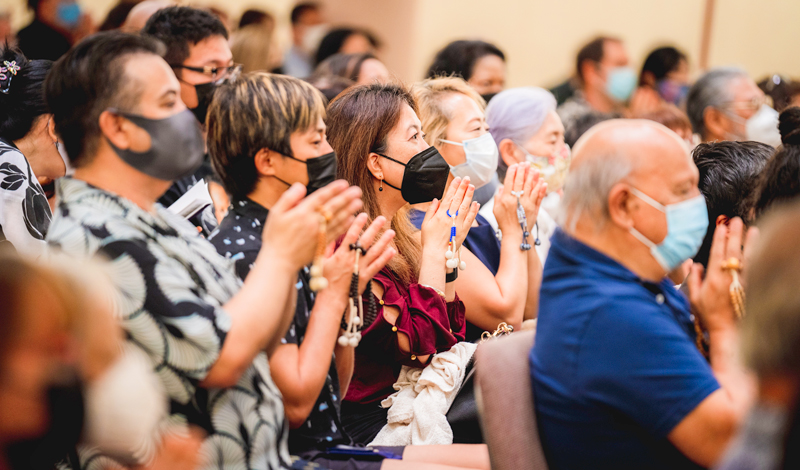There should be no discrimination among those who propagate the five characters of Myoho-renge-kyo in the Latter Day of the Law, be they men or women. Were they not Bodhisattvas of the Earth, they could not chant the daimoku.
“The True Aspect of All Phenomena,”
The Writings of Nichiren Daishonin, vol. 1, p. 385
Nichiren Daishonin was, in many ways, ahead of his time. This is true in the way he viewed equality among all people.
He wrote “The True Aspect of All Phenomena” in 1273, a time when women did not have many rights, and numerous Buddhist schools taught that women could not attain enlightenment. Yet, as the passage above indicates, Nichiren promoted equality among all practitioners, saying that “there should be no discrimination” among us.
Shakyamuni Buddha, too, taught in the Lotus Sutra that the enlightenment of women opens the way for all people’s enlightenment. But as time passed, various schools of Buddhism took the view that women were cut off from this path.
The story of the dragon king’s daughter exemplifies the Lotus Sutra’s teaching that women can attain enlightenment. Hearing the Lotus Sutra awakened the dragon girl’s desire to seek enlightenment. At the assembly described in the Lotus Sutra, the dragon girl showed actual proof of attaining Buddhahood in her present form. Her example indicates the liberating and egalitarian philosophy of Nichiren Buddhism that every living being can attain Buddhahood just as they are.
—Prepared by the SGI-USA Study Department
Ikeda Sensei’s Encouragement
1. A Philosophy of Complete Equality
The Lotus Sutra teaches that men and women are equally noble and respectworthy. In “Teacher of the Law,” the sutra’s 10th chapter, the Buddha instructs good men and women to expound the Law in his stead after his passing.[1] And in “Bodhisattva Never Disparaging,” its 20th chapter, Bodhisattva Never Disparaging[2] shows equal reverence to all of the four kinds of believers—monks, nuns, laymen and laywomen—eloquently attesting to the fact that women of every sphere, too, possess the Buddha nature and are worthy of praise and veneration.
For a long time in the history of Buddhism, however, this precious truth was forgotten and, as a result, women were caused great suffering. For that reason, by Nichiren Daishonin dedicating his life to realizing the enlightenment of women, it can be said that he severed that misguided legacy and enacted a great transformation that revived Buddhism as a religion of true equality.
“There should be no discrimination among those who propagate the five characters of Myoho-renge-kyo[3] in the Latter Day of the Law, be they men or women” (“The True Aspect of All Phenomena,” WND-1, 385). As these words indicate, the mission and the practice of Bodhisattvas of the Earth, who strive to lead all humanity to genuine happiness based on the Mystic Law, are firmly grounded in a view of humanity and the world in which both men and women are equal—that is, a philosophy of complete gender equality. (The Teachings for Victory, vol. 2, pp. 116–17)
2. Sharing Buddhism: A Practice of Supreme Compassion
Sharing Nichiren Daishonin’s philosophy is a key aspect of our Buddhist practice for attaining Buddhahood in this lifetime, a state of absolute happiness. …
By joyfully chanting Nam-myoho-renge-kyo and sharing Buddhism with others, we connect our lives with that of the Buddha, function as the Buddha’s emissaries and live as Bodhisattvas of the Earth. In other words, through this practice of faith for the sake of self and others alike, the power of the Buddha wells up within us and the life state of the Bodhisattvas of the Earth beats in our hearts. We are filled with great joy and a burning desire to help other living beings, and our lives are transformed.
Through that, we carry out our human revolution and transform our karma, thereby building a life state of absolute happiness.
Introducing others to Nichiren’s teachings—enabling others to resolve their sufferings on the most fundamental level and showing them the means for attaining a state of indestructible happiness—is also a practice of supreme compassion. It is the noblest thing we can do for the benefit of others and the highest good. It forges ties of true friendship and eternal bonds of familial love. (The New Human Revolution, vol. 25, pp. 12–13)
Feb. 3, 2023, World Tribune, p. 9
References
- See The Lotus Sutra and Its Opening and Closing Sutras, p. 205. ↩︎
- See LSOC, 308. ↩︎
- Myoho-renge-kyo is written with five Chinese characters, while Nam-myoho-renge-kyo is written with seven (nam, or namu, comprising two characters). The Daishonin often uses Myoho-renge-kyo synonymously with Nam-myoho-renge-kyo in his writings. ↩︎
You are reading {{ meterCount }} of {{ meterMax }} free premium articles

